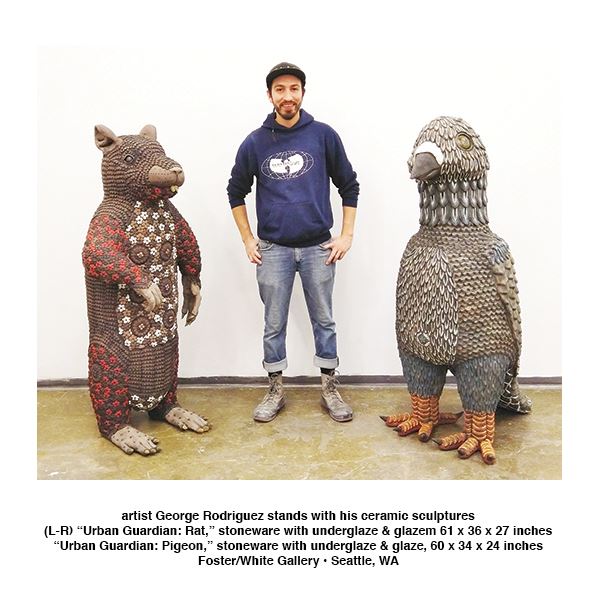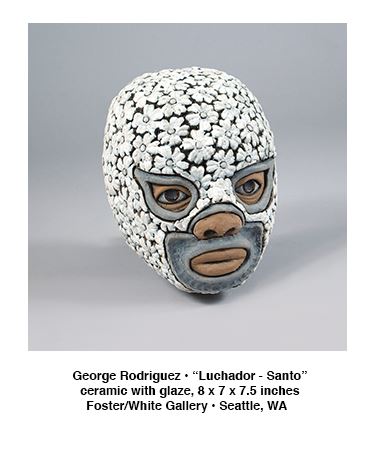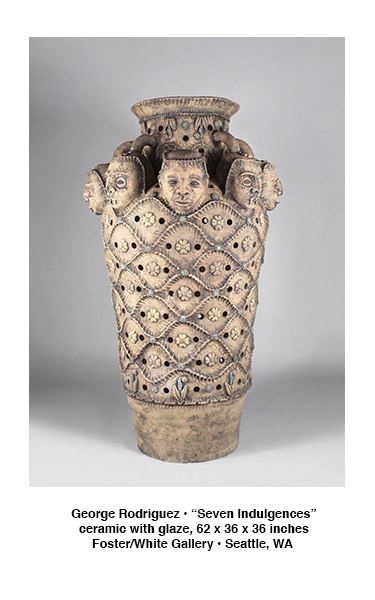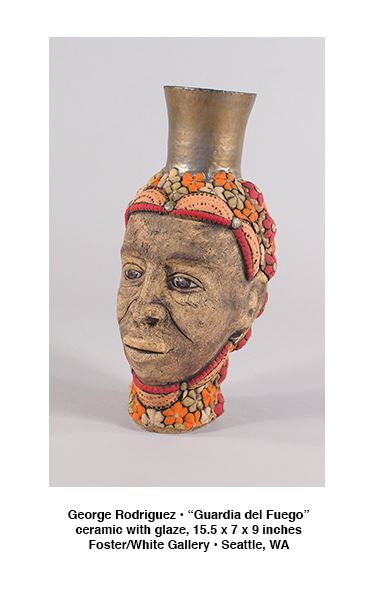
We could all use a little guardian right now. Someone (or something) that exists without our acknowledgment that would protect and guide us through these uncertain times. Or maybe we need something in the form of a spiritual message from beyond, our ancestors telling us to stay grounded because survival is both mandatory and attainable. Being hit with the double whammy of a pandemic and a social uprising is overwhelming but it doesn’t mean this is the death of resilience. What it does mean is that we need to be more resourceful at coping.
 Art is a healing and tangible source of comfort. It can be spiritual, religious, or magical and sometimes it’s a combination of all three. If you feel like you need a personal journey of reflection and healing, I strongly recommend you visit George Rodriguez’s show, “Urban Guardian,” at Foster/White gallery.
Art is a healing and tangible source of comfort. It can be spiritual, religious, or magical and sometimes it’s a combination of all three. If you feel like you need a personal journey of reflection and healing, I strongly recommend you visit George Rodriguez’s show, “Urban Guardian,” at Foster/White gallery.
A native of El Paso, Texas, Rodriguez celebrates his personal cultural background while pulling inspiration from many others. The “Urban Guardian” collection includes clay statues, vases, masks, headless bodies (or bodiless heads), that seamlessly combine Latino folklore, Greek mythology, and Italian architecture. An earlier example of this blending is from his “Lunar Vessel” group (not in this show) of clay animal-head vases that seem to be inspired by the Chinese zodiac with a Latino twist.
The brilliance of Rodriguez’s work is in the humor that lives just below the surface. But before you notice that, you have to combat a strange nagging feeling that there is something a little off or a bit dark about these guardians. Looking at some of headless statues that stand a little under two feet tall might give you the feeling that if you glanced away, they would quickly scramble or scuttle to follow you home. Or find a million ways to change places with your shadow.
There are more heads in the collection than there are bodies, which creates a choose-your-own-adventure feeling, giving you the freedom to combine the parts in any way. What if the sphinx-inspired body was adorned with the head of the a woman who had bright red lips and a bonnet of flowers? Or what would it mean if you gave the skull head to the body of the monk/priest figure? Are you playing god? Would you be upsetting the spirits or would you get to be the trickster for once? 
The storybook narrative continues in his piece “Seven Indulgences,” the largest in the show, standing about five feet tall. The ceramic vase is a 360° exploration that packs a tiny surprise. The faces that surround the top of the vase are gargoyles with stoic expressions and fangs. However, one gargoyle is very different. Peppered with wrinkles that collect around his eyes, along with some facial hair, there is no doubt that this is the face of a human. He’s not necessarily old, but he’s definitely someone who has seen a few things. The question is, how did he become part of this vase? What did he do to earn his place among the gargoyles? For that matter, how does anyone become art?
The dueling show stoppers of “Urban Guardian” are the rat and pigeon statues. Standing proudly, these two ceramic guardians have such a presence that when I first saw them, I found myself saying out loud, “Oh! Hello there!”
Rats and pigeons reoccur a lot in Rodriguez’s work, probably because they are the epitome of literal urban guardians. They populate every city environment, stirring and lurking through the streets. Rats, living below ground, are the protectors of the cities that they secretly run, while pigeons are the gatekeepers and defenders of the sky and parks.
Since Rodriguez makes these two usually discredited creatures the center of his show, it makes me wonder if he wants us to have a different understanding of these animals. What if we thought of them not as disgusting or diseased vermin, but as the preservers and gatekeepers of the surroundings we call home?
 One thing that’s not open to interpretation in George Rodriguez’s work is his attention to the details that go into each piece. Details so compelling that you can’t help but make up stories as you look at them. I wonder if the badge on the pigeon’s shoulder was awarded for its bravery. Or what has that head called “Ghost” seen that inspired the shocked expression on its face? Rodriguez knows, and he’s not saying. But that slight smirk behind all their eyes also invites you to calm your curiosity and let the spirit of his work guide you to a better place.
One thing that’s not open to interpretation in George Rodriguez’s work is his attention to the details that go into each piece. Details so compelling that you can’t help but make up stories as you look at them. I wonder if the badge on the pigeon’s shoulder was awarded for its bravery. Or what has that head called “Ghost” seen that inspired the shocked expression on its face? Rodriguez knows, and he’s not saying. But that slight smirk behind all their eyes also invites you to calm your curiosity and let the spirit of his work guide you to a better place.
All good artists tuck a little piece of themselves somewhere in their work. Rodriguez’s soft spot seems to be the eyes. Whether it’s the eyes of the devil that seem to track you from across the room or the stare of the wee man that appears fixated on a spot in front of him, their frozen but oddly animated faces all seem to express the quality of someone who is lost in thought or was recently interrupted in the middle of a sentence. And if you listen close enough you might be able to hear the words resting on their lips.
Rose McAleese
Rose McAleese is a writer, poet, and screenwriter born in Seattle. Currently living in Los Angeles because she figured what that city needed was one more writer.
“Urban Guardians” is on view August 6 through August 22 at the Foster/White Gallery, located at 220 Third Avenue South in Seattle, Washington. The gallery is open Tuesday through Saturday from 10 A.M. to 6 P.M. For more information, visit www.fosterwhite.com.